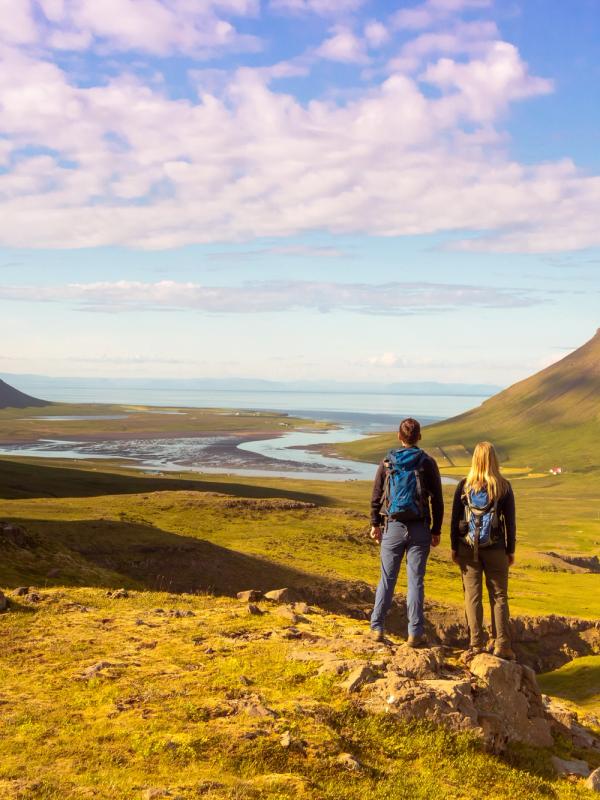
Hiking in Iceland in the Autumn
As the autumn leaves turn to fiery hues and the crisp air heralds a new season, it's a perfect time to explore the Icelandic wilderness. If you're considering hiking in Iceland during the fall, our camper van rental Iceland options can add an extra layer of convenience and comfort to your journey.
From the captivating Northern Lights displays to the rich colors of Icelandic foliage, autumn in Iceland is a magical time for outdoor adventures. So, embrace the season and make the most of your autumn hike with the flexibility of camper van rental in Iceland. Your dream Icelandic autumn expedition is just a click away.
Hiking the endless trails scattered across Iceland is always a rewarding experience, but hiking Iceland in Autumn is somehow even more magical. During this time, the most beautiful color change is sweeping across the volcanic island: violent bursts of rusty oranges, reds, and yellows come out in strength, and the endless sunlight that marked the summer is fading into the darkness of winter, bringing with it the magical reappearance of the northern lights.
On the hiking trails, you can expect moody skies, chilly weather, and bouts of showers; however, it all works together to take Iceland’s unreal landscapes to the next level. For many of us, this is our favorite season, and spend a little time hiking, and you’ll quickly see why. This article explores all you need to know about hiking in Iceland during autumn, what to expect, and everything else that goes into organizing a camper van holiday in this wonderful season.
Iceland’s Most Scenic Hiking Trails in the Autumn
While many people might have their eyes on completing the Fimmvörðurháls hike, come October, this isn’t possible, and only accessible in September if the snow stays away. Instead, we recommend sticking to these tried and tested hikes for your campervan trip in the autumn.
Reykjadalur Hot Spring Hike – South Iceland
Now one of the most well-known hiking trails in the country, autumn is the last chance to experience this beautiful and easy hike to the rewarding hot spring river. The colors in the landscape here are spectacular in this season, and mixed with the already fascinating geothermal features, makes, this one of the best hikes to do in the autumn. The trail is a bit quieter than the summertime, but we still recommend either going early or late. If you’re there in the evening, there’s always a chance to catch the northern lights while you soak in the 40°C water.
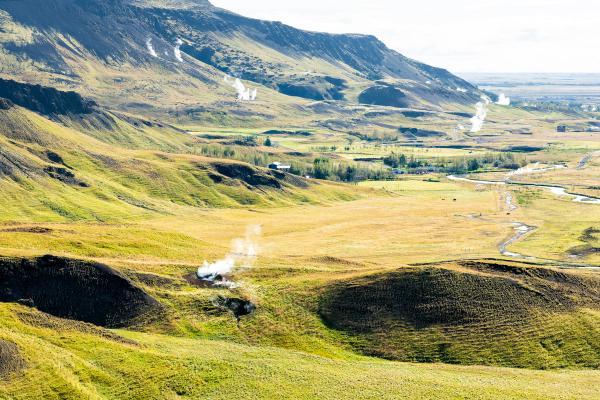
Stuðlagil Canyon – East Iceland
One of the newest natural attractions in Iceland is Stuðlagil Canyon in East Iceland. This fantastic glacial canyon is filled with twisted basalt columns, the dark greys set off by the bright blue-green water and the rusty red of the surrounding rocks. The hike is an easy one – about an hour over level ground to get to the canyon. Once you’re there, you can also clamber down to the canyon’s base, getting up close and personal with the impressive basalt formations.
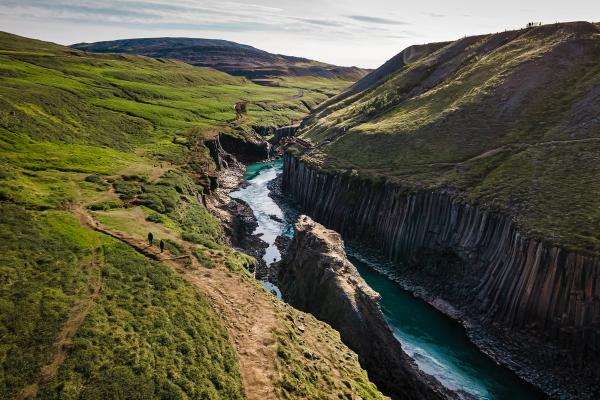
Arnarstapi to Hellnar – Snæfellsnes Peninsula
This has long been one of the most popular hikes on the Snæfellsnes Peninsula, thanks to its accessibility most of the year. The trail is easy, takes in some rugged and beautiful coastline, and has hot coffee waiting at either end. It’s also a great place to witness the changing of the season—the lush green grass is fading into yellow, dramatically clashing with the black volcanic rocks of the coastline and stormy grey waters.
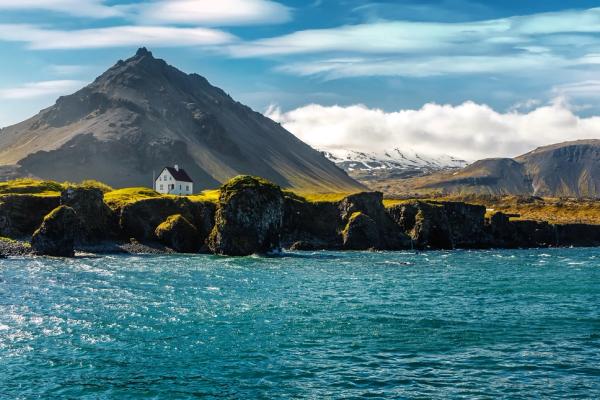
Glymur Waterfall – West Iceland
The already fantastic colors along the trail to Glymur Waterfall make one final blaze before the winter closes in. This is the last chance to clamber up to Iceland’s second-tallest waterfall, as during the winter, the trail is closed. However, great care must still be taken on this trek. The river that you cross on the log is dangerously close to flowing over it, making the crossing slippery and wet. But if it’s OK, this is a spectacular hike that gives you great views over the fjord and a real taste of the changing colors of the Icelandic Autumn. 4 hours round trip.

Skaftafell Nature Reserve – Southeast Iceland
Another great area to really enjoy the Autumn scenery is Skaftafell Nature Reserve in far southeast Iceland. This is one of the coolest places to hike, the little pocket of awesome nature offering plenty of different trails of varying difficulty right beneath Vatnajökull, the largest glacier in Europe. The muted tones of autumn and dramatic weather in the area bring a real sense of foreboding about the winter ahead, a very raw and powerful experience. Try the trail to Svartifoss, or if the weather allows, go all the way to the Sjónarnípa viewpoint for the best vista of the glacier tongue spilling out between mountains.

Hverfjall Volcanic Crater – Lake Myvatn, North Iceland
One of the most spectacular views of Lake Myvatn can be found at the top of Hverfjall, a black volcanic crater on the eastern side of the lake. It’s tough going up to the top, so the cooler weather and overcast days are welcome. This entire area in the north is one of the most beautiful in Iceland, and the autumn is no exception. Snows usually come a bit earlier to the north but also clear quickly if it does, meaning that you can expect patches of white amongst all the orange and brown of the mossy lava landscapes.
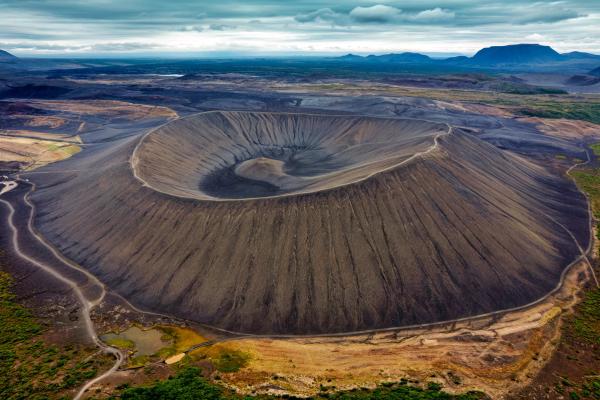
Iceland Weather in Autumn – September and October
Iceland’s weather in autumn is often at its most dramatic, with quick changes in the conditions that can happen at the drop of a hat. Fierce winds buffeting the country might whip up a storm, only for it to be beaten away half an hour later by the emerging sun. It’s exciting, but for the most part, expect the weather to be overcast, cool, and windy. This is another of the reasons why hiking during this season is so good.
The rainiest month in Iceland is in October, with an average of around 15.5 rainy days out of the month. However, you should know that the rainfall in Iceland is, in general, quite light – don’t expect any torrential downpours to put a stop to your hike.
The average temperature in Iceland during autumn is as follows: the average low temperature during September is 6°C (43°F), while the average high temperature is around 11°C (52°F). The average low temperature in October is 3°C (37°F), while the average high temperature is 7°C (45°F). That’s chilly! Which brings us to our next point.

What to Wear in Iceland During Autumn?
Obviously, when the weather is all over the place, you must pack for all types of conditions. A strong pair of waterproof hiking boots are recommended year-round. Still, the Autumn also calls for you to have a rain jacket, weatherproof pants, and an extra layer or two if there’s a cold snap – think of a pair of long johns underneath your pants and a thin thermal shirt as one of your top layers underneath a woolen jumper and jacket. A beanie and gloves are also recommended.
Here’s what you should pack for a trip to Iceland in September or October:
Bottom Layer:
- Thermal leggings
- Active, weatherproof pants
- Rain pants for heavier rainfall
Top Layer:
- Thermal base
- Light fleece
- Wool sweater
- Thick parka
- Rainproof jacket for heavier rainfall
Iceland Daylight Hours in September
Wondering when it’s dark enough to settle into your cozy camper? Look no further. The Iceland daylight hours in September mark a return to ‘regular’ light conditions in the country. At the beginning of the month, sunrise is around 6 am, while sunset is just before 9 pm.
Iceland in October obviously gets darker much faster. At the beginning of the month, sunrise has shifted to around 7:30 am, with sunset at around 7 pm. But by the end of October, winter is well and truly on the horizon, with a sunrise just after 9 am and the sun setting around 5:15 pm.
September: Between 14–11 hours of daylight. October: Between 11–8 hours of daylight.
Can I See the Northern Lights in Iceland in September?
The dark nights mean that, yes, you can see the northern lights during September and October. In fact, the weather is often calmer during this season than it is in the winter, meaning they might appear more than they do in December and January. Keep your eyes peeled, and don’t forget to check out our article about the best locations to see the northern lights in Iceland.
Driving a Campervan in Iceland in Autumn
If you’re planning on visiting Iceland during autumn, be aware that the conditions on the road are usually wet and slippery, so great care must be taken when driving around the country. There can also be banks of fog that hover over the mountain passes, making visibility difficult. Most of Iceland is still accessible however the highland routes have closed. It also pays to watch out for large groups of sheep, as the first two weeks of September are when the Icelandic farmers are rounding up their herds for the winter.
During this time, it can sometimes be hard to tell through research beforehand whether a campsite is open or not. Most campsites that close over the winter only do so when the traffic has slowed down, which means that if it’s still busy, they’ll stay open longer. However, most of the main campsites around the ring road will be open – check out our useful map of year-round campsites ) for more information and help planning.
Conclusion
Hiking in Iceland during autumn is a great experience, with colorful landscapes, cooler temperatures, and fewer crowds on the trails. Some hikes, like Reykjadalur and Skaftafell, are perfect for this season, while others, like Fimmvörðurháls, become inaccessible as winter approaches. The weather is unpredictable, with wind, rain, and sudden changes, so packing the right gear is important. Shorter daylight hours mean it’s also a good time to see the northern lights. Driving conditions can be tricky, with wet roads and fog, but most main routes and campsites remain open. With the right preparation, autumn is one of the best times to explore Iceland on foot.
